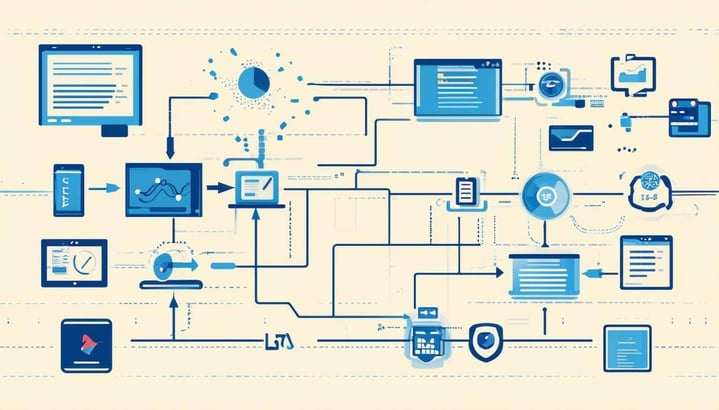Struggling to keep customers engaged and loyal? The problem might be hiding in your data.
In today’s fast-moving digital world, delivering a personalized experience isn’t just a competitive edge—it’s an expectation. Yet, many businesses still rely on disconnected tools and scattered data, making it nearly impossible to truly understand their customers or anticipate their needs.
Without a clear, unified view of your audience, marketing efforts become guesswork. Campaigns miss the mark. Customers feel unseen. And loyalty? It fades.
So, how can your business break free from data silos and turn scattered insights into meaningful action?
The answer lies in building a Unified Data Ecosystem—a system where all your customer data flows seamlessly, empowering you to deliver personalized experiences that drive long-term loyalty and retention.
In this post, we’ll explore:
- What a Unified Data Ecosystem is,
- Why it’s critical for personalization and retention,
- The hidden costs of disconnected data,
- And how to overcome the most common challenges in unifying your data.
Let’s dive in and unlock the power of your data.
What Is a Unified Data Ecosystem?
Imagine having all your customer data—purchases, website visits, email interactions, and social media engagement—in one place, working together to give you a complete picture of your audience. That’s the power of a Unified Data Ecosystem.

Definition:
A Unified Data Ecosystem is a fully integrated system where customer data flows seamlessly between marketing, sales, and service tools. It connects every touchpoint to provide a single source of truth, enabling smarter decisions and personalized customer experiences.
Key Components:
- CRM Integration: Centralizes customer data across teams, breaking down silos between marketing, sales, and service.
- First-Party Data Collection: Gathers consent-based data directly from customers through websites, email sign-ups, and purchase history.
- Automation & AI Tools: Streamlines workflows, automates data syncing, and powers predictive analytics for customer targeting.
- Unified Reporting Dashboard: Provides real-time, actionable insights to measure performance and improve strategies.
Real-World Example:
Let’s say an online clothing store uses Shopify to manage sales, Mailchimp for emails, and Google Analytics for tracking website traffic. Without integration, these systems operate in isolation, making it hard to understand customer behavior.
With a Unified Data Ecosystem, all these tools sync seamlessly. Now, the store can send personalized emails recommending products based on past purchases and browsing history—all while tracking how these efforts impact sales in real-time.
Why It Matters for Personalization and Retention
In today’s competitive market, customers expect brands to understand their needs and deliver experiences that feel personal and relevant. A Unified Data Ecosystem is the foundation for meeting—and exceeding—those expectations.
Here’s why it’s a game-changer:
1. Personalization at Scale
Disconnected tools limit your ability to deliver meaningful interactions. A unified system connects all your data, enabling personalized messaging, product recommendations, and promotions based on real customer behavior.
📌 Example:
Instead of sending the same email to your entire list, a unified system lets you send targeted product recommendations to customers based on their past purchases or browsing habits.
2. Seamless Customer Experiences
Customers interact with your brand across multiple channels—website, email, social media, and more. A Unified Data Ecosystem ensures every interaction feels connected and consistent.
📌 Example:
A customer who abandons a cart online could automatically receive a personalized email with a discount to complete the purchase.

Grow your E-Commerce with a CRM
Learn how to use HubSpot's free tools in this online course.
- Step-by-step videos
- Worksheets
- Ready to use assets.
- 30min Strategy Call
3. Smarter, Data-Driven Decisions
When all your data lives in one place, it’s easier to spot trends, understand what’s working, and adjust campaigns in real-time. No more relying on assumptions or outdated reports.
📊 Statistic:
Marketers who use first-party data are 93% more likely to say their team is outperforming goals than those who don’t. (HubSpot, The State of Data-Driven Advertising)
4. Stronger Customer Loyalty and Retention
Personalized, relevant interactions make customers feel understood and valued. This emotional connection builds trust and keeps them coming back.
📌 Example:
Loyalty programs that reward customers based on their shopping habits foster long-term relationships and encourage repeat purchases.
The Cost of Disconnected Data

While most businesses recognize the value of customer data, many underestimate the true cost of disconnected systems. When data is scattered across tools and platforms, it creates invisible roadblocks that can seriously hinder growth.
Here’s how fragmented data holds your business back:
1. Inconsistent Customer Experiences
Without integrated data, customers receive mixed messages. They might get a discount for a product they just purchased or be targeted with irrelevant ads. This inconsistency weakens trust and damages brand loyalty.
📌 Example:
A customer buys a product but still receives ads promoting the same item instead of complementary products or a thank-you message.
2. Inaccurate Reporting and Missed Insights
Manual data handling and disconnected reports make it difficult to measure marketing performance accurately. This results in blind spots, poor decision-making, and missed opportunities.
📌 Example:
If your email marketing tool isn’t connected to your sales data, how can you tell which campaigns are actually driving purchases?
3. Wasted Marketing Budget
When teams operate in silos, marketing dollars often get wasted on campaigns that aren’t aligned with customer needs or business goals. Resources are spent on broad, generic campaigns rather than targeted efforts that convert.
📌 Statistic:
Only 16% of marketers have full visibility into the customer journey, making it difficult to tie marketing activities directly to revenue. (HubSpot, The State of Data-Driven Advertising)
4. Slower Growth and Scalability
Disconnected tools slow down your ability to adapt and scale. Without a streamlined system, launching new campaigns or entering new markets becomes cumbersome and inefficient.
📌 Example:
An e-commerce business using spreadsheets and multiple reporting tools struggles to scale its marketing efforts without a unified system.
Overcoming Common Challenges
Building a Unified Data Ecosystem may seem like a big task, but the right strategies and tools can simplify the process. Let’s break down the most common challenges and how to overcome them.
1. Data Integration Hurdles
Challenge: Struggling to connect tools like Shopify, WooCommerce, email marketing platforms, and CRMs.
Solution:
- Adopt Integrated Tools: Choose platforms that offer native integrations or use third-party connectors (e.g., HubSpot, Zapier).
- APIs for Custom Integrations: For more complex needs, leverage APIs to connect your e-commerce, CRM, and marketing tools.
📌 Tip: Start by integrating your highest-impact tools—like your CRM and email marketing platform—to see immediate improvements.
2. Data Quality and Accuracy
Challenge: Incomplete, outdated, or inconsistent data makes personalization ineffective.
Solution:
- Implement Data Cleaning Processes: Regularly audit and cleanse data to remove duplicates and outdated entries.
- Standardize Data Entry: Use consistent data entry formats and validation rules to maintain accuracy across systems.
📌 Statistic: 42% of marketers struggle to ensure first-party data quality and accuracy. (HubSpot, The State of Data-Driven Advertising)
3. Navigating Privacy Regulations
Challenge: Growing privacy regulations (GDPR, CCPA) and consumer distrust make data collection harder.
Solution:
- Focus on First-Party Data: Collect data directly from customers through consented channels like loyalty programs, surveys, and gated content.
- Transparent Data Practices: Be upfront about how customer data is collected and used to build trust.
📌 Statistic: 75% of consumers view data privacy as a human right, increasing expectations for transparency. (HubSpot, The State of Data-Driven Advertising)
4. Scalability of Data Systems
Challenge: Current tools and systems can’t scale with business growth.
Solution:
- Invest in Scalable Solutions: Choose tools that can handle increasing data volumes and adapt to business needs.
- Cloud-Based Systems: Use cloud-based CRMs and analytics tools for flexibility and scalability.
📌 Tip: Look for systems with modular features that grow with your business instead of requiring complete overhauls.
Closing the Gap
By addressing these challenges head-on, your business can lay the foundation for a fully integrated data system that fuels smarter marketing, stronger personalization, and higher retention.
Up Next: In the next post, we’ll break down a step-by-step guide to help you start building your Unified Data Ecosystem.



